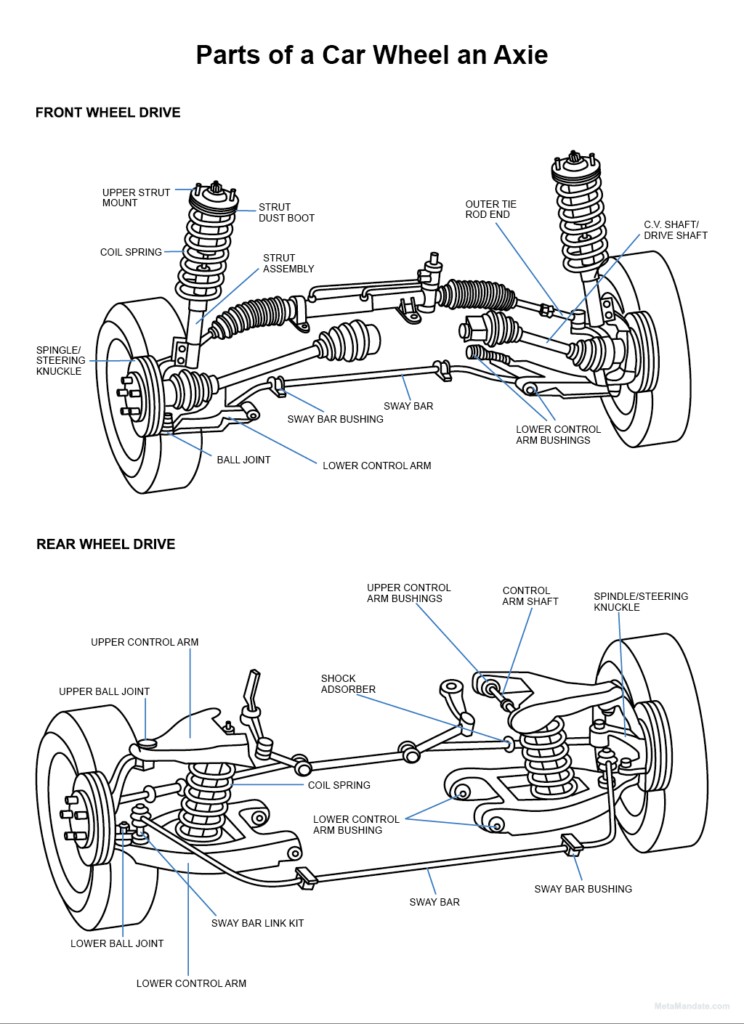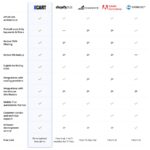Understanding the anatomy of your car’s wheel and axle is crucial for vehicle maintenance and ensuring a smooth, safe ride. While often taken for granted, these components are vital for your car’s mobility and overall performance. This guide will break down the thirteen key Parts Of A Car Wheel And Axle, explaining their names and functions in detail.
Keep reading to become more familiar with these essential automotive elements!
Delving into the Wheel and Axle Components
 Detailed view of labeled car wheel and axle parts
Detailed view of labeled car wheel and axle parts
1. Tires: The Road Contact Point
Tires are arguably the most recognized and critical part of your car’s wheel assembly. These ring-shaped structures, typically constructed from robust rubber, carbon black, and various synthetic compounds, serve as the protective outer layer of the wheel.
Crucially, tires are the sole component of your vehicle that directly interacts with the road surface. Their primary function is to absorb shocks and vibrations from uneven terrain, providing cushioning that prevents damage to the car and ensures a comfortable ride.
2. Rim: The Wheel’s Foundation
Often mistaken for the entire wheel, the rim is actually a distinct part of the wheel assembly. The rim is the inner circumference that sits directly beneath the tire. It is typically made from durable materials like steel or aluminum alloy.
The rim’s robust construction is necessary to bear the vehicle’s entire weight. Modern rims are also designed with tubeless configurations, creating an airtight seal between the tire and the hub, which is essential for maintaining tire pressure. Therefore, the rim’s main role is to provide a secure and airtight base for the tire.
3. Hub: The Central Connection Point
The hub is the central component of the wheel, easily identifiable by the protruding metal studs. These studs, known as wheel studs or bolts, are used to attach the wheel and, consequently, the entire wheel assembly to the car’s axle.
Beyond connection, the hub also plays a role in braking. It houses brake discs or drums that work in conjunction with the brake calipers to bring the vehicle to a stop when the brake pedal is applied. Furthermore, the hub contains rotors, which are crucial for the wheel’s rotation and the overall smooth operation of the car’s movement system.
4. Wheel Bearings: Enabling Smooth Rotation
Wheel bearings are integral components located within the hub and are fundamental to the wheel’s structural integrity and functionality. These bearings act as the crucial interface between the rotating wheel and the stationary axle. They are designed to carry the vehicle’s load while allowing the wheel to rotate freely with minimal friction.
Due to their constant exposure to load and road vibrations, wheel bearings are susceptible to wear and tear. Proper maintenance and timely replacement are essential to prevent damage and ensure smooth, safe driving. Their tight integration within the hub is vital to protect them from road debris and contaminants that could accelerate wear.
5. Flanges and Beads: Ensuring Tire Stability
If you examine the edges of your tires, you’ll notice distinct, slightly protruding edges called flanges. Within these flanges reside beads, which are reinforced rings made of steel cable encased in rubber. Together, the flanges and beads are critical for maintaining tire stability across varied road conditions. They achieve this by effectively transferring the engine’s power to the wheel, ensuring consistent contact and grip.
Damage to either the flanges or beads can disrupt this energy transfer, leading to vehicle instability and vibrations, especially at higher speeds. Therefore, inspecting tire sidewalls for damage to flanges and beads is a part of regular tire maintenance.
6. Valve System: Tire Inflation Control
The valve system is responsible for managing the inflation and deflation of your tires, directly impacting tire pressure. This system typically incorporates one of three main valve types, with the optimal choice depending on factors like vehicle type and manufacturer specifications. Common types include Schrader valves, Presta valves, and Woods valves.
Each valve assembly primarily consists of three key parts: the valve core, the valve cap, and sometimes a valve extension. The core and cap work in tandem to create an airtight seal, preventing air leakage from the tire. The valve extension, if present, facilitates easier access for checking and adjusting tire pressure, especially in dual-wheel configurations or with certain wheel covers.
7. Constant Velocity Joints (CV Joints): Facilitating Flexible Movement
Analogous to the joints in your body, Constant Velocity (CV) joints in a car enable the vehicle’s “limbs” – the wheels – to move freely and flexibly. CV joints connect the wheels to the car’s transmission system. This connection is essential for allowing the wheels to rotate fully and smoothly, especially when steering and navigating turns.
Beyond enabling rotation, CV joints also transmit torque from the transmission to the wheels, providing the necessary power for movement. They are designed to maintain constant velocity even when the wheels are turning at different angles, ensuring smooth power delivery and preventing jerky movements during cornering.
8. Axle Housing: Protecting Internal Components
The axle housing serves as a robust enclosure for the axle’s internal components, protecting them from external elements and physical damage. Typically constructed from heavy-duty metals, the housing is designed to withstand harsh road conditions and impacts.
The axle housing is connected to the vehicle’s chassis via axle bearings, with the center hanger bearing being particularly important in multi-piece driveshafts. The center hanger bearing provides crucial support and stability to the axle housing, minimizing vibrations and preventing excessive movement, particularly during driving.
9. Differential: Managing Wheel Speed Differences
The differential is a crucial component within the axle assembly responsible for maintaining vehicle stability when wheels rotate at different speeds, most notably during turns. When a car turns, the outer wheels travel a greater distance than the inner wheels, requiring them to rotate faster. The differential allows for this speed difference between the wheels while still providing power to both.
A differential comprises various gears, including spider gears and a ring gear. These gears work in concert to distribute torque unevenly to the wheels, allowing for different rotational speeds and ensuring that power is delivered effectively to both the front and rear axles as needed.
10. Driveshafts: Transmitting Rotational Power
Driveshafts are responsible for transferring rotational power from the engine and transmission to the wheels. There are typically two main types of driveshafts: the propeller shaft and shorter CV driveshafts. While they may differ in length and specific application, their fundamental function remains the same.
Both types of driveshafts work in conjunction with the car’s differentials to provide a smooth driving experience. They transmit the rotational energy generated by the engine to the front and rear axles, ultimately powering the wheels and propelling the vehicle forward.
11. Gaskets: Sealing and Preventing Leaks
Gaskets, though small, are vital components within the axle assembly. They act as seals, creating tight junctions between various parts such as the transmission, differentials, driveshafts, and the axle housing. These seals are crucial for preventing leaks and maintaining the integrity of the system. Gaskets are essential for ensuring a smooth and efficient ride by preventing fluid loss and contamination.
Importantly, gaskets are responsible for sealing gearbox fluid (transmission fluid) within the system. Preventing fluid leakage is critical as fluid loss can lead to internal damage to the axle’s differential or transmission due to inadequate lubrication and overheating.
12. Mounting Humps: Securing Tire Mounting
Mounting humps are a key design feature of the wheel rim that plays a crucial role in securely mounting tires onto the wheels. Their slanted shape and ridged design are specifically engineered for this purpose.
The humps encircle the wheel’s barrel and create a secure seating area for the tire beads. This design effectively separates the beads and flanges, ensuring that the tires are firmly locked onto the wheels, even under high-speed conditions and during sharp maneuvers. This secure mounting is paramount for safety and optimal tire performance.
13. Transfer Case: Distributing Power in 4WD Vehicles
The transfer case is a component specifically found in four-wheel-drive (4WD) and all-wheel-drive (AWD) vehicles. It is located centrally within the drivetrain, typically between the front and rear axles, and is connected to the transmission and driveshafts.
The transfer case’s primary function is to selectively transfer power between the front and rear axles. This allows for optimized power distribution, ensuring balanced traction, especially when driving in challenging conditions like off-road terrains or slippery surfaces. It enables the vehicle to switch between two-wheel drive and four-wheel drive modes as needed, enhancing versatility and control.
